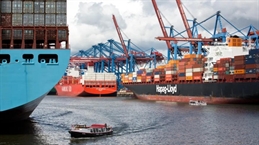
The Gemini cooperation agreement between Maersk and Hapag-Lloyd will rely heavily on a small number of transhipment hubs to support its new network, according to a new analysis by Drewry.
The independent maritime research consultancy firm said the operational performance of several of the terminals is assessed to be world-class in terms of intensity of asset use, but Drewry said that strong performance will be essential if the hub-and-spoke strategy is to succeed.
"Since the announcement by MSC and Maersk in January 2023 that the 2M alliance would end in early 2025, the industry has been watching and wondering how each partner will 'go it alone' on the major trade lanes covered by the agreement," Drewry said in its new report.
It added that, as it turns out, Maersk will not be setting out solo. In January 2024, it announced that it would instead enter into a new cooperation agreement — Gemini — with leading German carrier Hapag-Lloyd, which will take effect in February 2025, immediately after the end of the 2M alliance.
The Gemini cooperation agreement covers seven trades — Asia/USWC, Asia/USEC, Asia–/Middle East, Asia/Mediterranean, Asia/North Europe, Middle East-India/Europe and Transatlantic.
Drewry noted that the network comprises 26 mainline services supported by 32 dedicated shuttle routes.
"The planned network streamlines the number of port calls in each region with the aim of reducing disruption. As a result, the loops are focussed heavily on 'hub & spoke' transhipment hubs supported by high-capacity dedicated shuttle loops that link the regional hubs with other gateway ports," it added.
In total, the mainline services will call at only 56 ports, with a further 29 ports served by dedicated shuttles.
Drewry reviewed the planned network to look at the selected hub terminals and assess their readiness to support the shuttle feeder strategy in the recently published Ports and Terminals Insight report.
"The services operated under the Gemini cooperation agreement will make extensive use of 15 hub ports," Drewry said.
It noted that APMT operates terminals in eight of the selected ports, with Hapag-Lloyd having operational terminals in two of the ports while investing in a third.
Drewry added that the "high level" of ownership across the hub port network provides the partners with a greater degree of control over operational management and investment plans — both of which will be key to the success of the hub-and-spoke strategy the partnership will employ.
"Several of the selected hub ports are already world leaders in terms of operational performance — APMT's facilities in Tanger Med are both handling over 2,000 TEU per metre of quay and more than 200,000 TEU per crane, as is APMT Salalah," the independent maritime research consultancy firm, said.
Meanwhile, it added that Tanjung Pelepas, Singapore, East Port Said and Algeciras — all of which handle high levels of transhipment — also rank highly in Drewry's annual survey of terminal performance.
Capacity expansion projects across the network are also well advanced at the hub ports where utilisation levels are high.
The analysis noted that the pipeline of investments is spread across the physical expansion of terminal assets (e.g. Rotterdam, East Port Said, Tangier MedPort), upgrade of capability to handle ULCVs (e.g. Bremerhaven, Salalah) and automation/digitalisation initiatives (e.g. Wilhelmshaven, Shanghai).
"While the use of high-capacity dedicated shuttle services will facilitate efficient use of yard space at the hub ports, any repeat of the supply chain disruption seen in 2021-22 will put the Gemini network strategy under extreme pressure," Drewry said.
"The hub ports will need to provide sufficient buffer storage to make up for any mainline or feeder vessel delays," it added.




